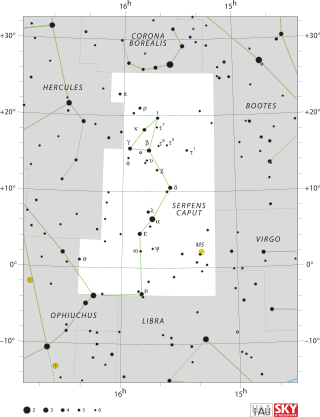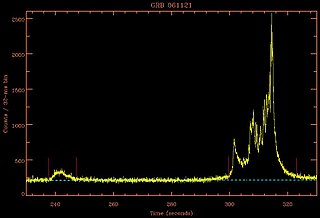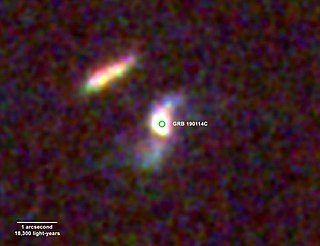
Fornax is a constellation in the southern celestial hemisphere, partly ringed by the celestial river Eridanus. Its name is Latin for furnace. It was named by French astronomer Nicolas Louis de Lacaille in 1756. Fornax is one of the 88 modern constellations.

Serpens is a constellation in the northern celestial hemisphere. One of the 48 constellations listed by the 2nd-century astronomer Ptolemy, it remains one of the 88 modern constellations designated by the International Astronomical Union. It is unique among the modern constellations in being split into two non-contiguous parts, Serpens Caput to the west and Serpens Cauda to the east. Between these two halves lies the constellation of Ophiuchus, the "Serpent-Bearer". In figurative representations, the body of the serpent is represented as passing behind Ophiuchus between Mu Serpentis in Serpens Caput and Nu Serpentis in Serpens Cauda.

In gamma-ray astronomy, gamma-ray bursts (GRBs) are immensely energetic explosions that have been observed in distant galaxies, described by NASA as "the most powerful class of explosions in the universe". They are the most energetic and luminous electromagnetic events since the Big Bang. Bursts can last from ten milliseconds to several hours. After an initial flash of gamma rays, a longer-lived "afterglow" is usually emitted at longer wavelengths.

Neil Gehrels Swift Observatory, previously called the Swift Gamma-Ray Burst Explorer, is a NASA three-telescope space observatory for studying gamma-ray bursts (GRBs) and monitoring the afterglow in X-ray, and UV/Visible light at the location of a burst. It was launched on 20 November 2004, aboard a Delta II launch vehicle. Headed by principal investigator Neil Gehrels until his death in February 2017, the mission was developed in a joint partnership between Goddard Space Flight Center (GSFC) and an international consortium from the United States, United Kingdom, and Italy. The mission is operated by Pennsylvania State University as part of NASA's Medium Explorer program (MIDEX).

The Gamma-Ray Burst Optical/Near-Infrared Detector (GROND) is an imaging instrument used to investigate Gamma-Ray Burst afterglows and for doing follow-up observations on exoplanets using transit photometry. It is operated at the 2.2-metre MPG/ESO telescope at ESO's La Silla Observatory in the southern part of the Atacama desert, about 600 kilometres north of Santiago de Chile and at an altitude of 2,400 metres.

GRB 970508 was a gamma-ray burst (GRB) detected on May 8, 1997, at 21:42 UTC; it is historically important as the second GRB with a detected afterglow at other wavelengths, the first to have a direct redshift measurement of the afterglow, and the first to be detected at radio wavelengths.
The history of gamma-ray began with the serendipitous detection of a gamma-ray burst (GRB) on July 2, 1967, by the U.S. Vela satellites. After these satellites detected fifteen other GRBs, Ray Klebesadel of the Los Alamos National Laboratory published the first paper on the subject, Observations of Gamma-Ray Bursts of Cosmic Origin. As more and more research was done on these mysterious events, hundreds of models were developed in an attempt to explain their origins.

GRB 090423 was a gamma-ray burst (GRB) detected by the Swift Gamma-Ray Burst Mission on April 23, 2009, at 07:55:19 UTC whose afterglow was detected in the infrared and enabled astronomers to determine that its redshift is z = 8.2, making it one of the most distant objects detected at that time with a spectroscopic redshift.
X-ray emission occurs from many celestial objects. These emissions can have a pattern, occur intermittently, or as a transient astronomical event. In X-ray astronomy many sources have been discovered by placing an X-ray detector above the Earth's atmosphere. Often, the first X-ray source discovered in many constellations is an X-ray transient. These objects show changing levels of X-ray emission. NRL astronomer Dr. Joseph Lazio stated: " ... the sky is known to be full of transient objects emitting at X- and gamma-ray wavelengths, ...". There are a growing number of recurrent X-ray transients. In the sense of traveling as a transient, the only stellar X-ray source that does not belong to a constellation is the Sun. As seen from Earth, the Sun moves from west to east along the ecliptic, passing over the course of one year through the twelve constellations of the Zodiac, and Ophiuchus.
GRB 011211 was a gamma-ray burst (GRB) detected on December 11, 2001. A gamma-ray burst is a highly luminous flash associated with an explosion in a distant galaxy and producing gamma rays, the most energetic form of electromagnetic radiation, and often followed by a longer-lived "afterglow" emitted at longer wavelengths.
GRB 030329 was a gamma-ray burst (GRB) that was detected on 29 March 2003 at 11:37 UTC. A gamma-ray burst is a highly luminous flash associated with an explosion in a distant galaxy and producing gamma rays, the most energetic form of electromagnetic radiation, and often followed by a longer-lived "afterglow" emitted at longer wavelengths. GRB 030329 was the first burst whose afterglow definitively exhibited characteristics of a supernova, confirming the existence of a relationship between the two phenomena.
GRB 070714B was a gamma-ray burst (GRB) that was detected on 14 July 2007 at 04:59 UTC. A gamma-ray burst is a highly luminous flash associated with an explosion in a distant galaxy and producing gamma rays, the most energetic form of electromagnetic radiation, and often followed by a longer-lived "afterglow" emitted at longer wavelengths.

GRB 090429B was a gamma-ray burst observed on 29 April 2009 by the Burst Alert Telescope aboard the Swift satellite. The burst triggered a standard burst-response observation sequence, which started 106 seconds after the burst. The X-ray telescope aboard the satellite identified an uncatalogued fading source. No optical or UV counterpart was seen in the UV–optical telescope. Around 2.5 hours after the burst trigger, a series of observations was carried out by the Gemini North telescope, which detected a bright object in the infrared part of the spectrum. No evidence of a host galaxy was found either by Gemini North or by the Hubble Space Telescope. Though this burst was detected in 2009, it was not until May 2011 that its distance estimate of 13.14 billion light-years was announced. With 90% likelihood, the burst had a photometric redshift greater than z = 9.06, which would make it the most distant GRB known, although the error bar on this estimate is large, providing a lower limit of z > 7.

GRB 101225A, also known as the "Christmas burst", was a cosmic explosion first detected by NASA's Swift observatory on Christmas Day 2010. The gamma-ray emission lasted at least 28 minutes, which is unusually long. Follow-up observations of the burst's afterglow by the Hubble Space Telescope and ground-based observatories were unable to determine the object's distance using spectroscopic methods.

A kilonova is a transient astronomical event that occurs in a compact binary system when two neutron stars or a neutron star and a black hole merge. These mergers are thought to produce gamma-ray bursts and emit bright electromagnetic radiation, called "kilonovae", due to the radioactive decay of heavy r-process nuclei that are produced and ejected fairly isotropically during the merger process. The measured high sphericity of the kilonova AT2017gfo at early epochs was deduced from the blackbody nature of its spectrum.

The Space Variable Objects Monitor (SVOM) is a planned small X-ray telescope satellite under development by China National Space Administration (CNSA), Chinese Academy of Sciences (CAS) and the French Space Agency (CNES), to be launched on 24 June 2024.

A gamma-ray precursor is a short X-ray outburst event that comes before the main outburst of the gamma-ray burst progenitor. There is no consensus on the mechanism for this event, although several theories have been suggested.

GRB 190114C was an extreme gamma-ray burst explosion from a galaxy 4.5 billion light years away (z=0.4245; magnitude=15.60est) near the Fornax constellation, that was initially detected in January 2019. The afterglow light emitted soon after the burst was found to be tera-electron volt radiation from inverse Compton emission, identified for the first time. According to the astronomers, "We observed a huge range of frequencies in the electromagnetic radiation afterglow of GRB 190114C. It is the most extensive to date for a gamma-ray burst." Also, according to other astronomers, "light detected from the object had the highest energy ever observed for a GRB: 1 Tera electron volt (TeV) -- about one trillion times as much energy per photon as visible light"; another source stated, "the brightest light ever seen from Earth [to date].".

GRB 221009A also known as Swift J1913.1+1946 was an extraordinarily bright and long-lasting gamma-ray burst (GRB) jointly discovered by the Neil Gehrels Swift Observatory and the Fermi Gamma-ray Space Telescope on October 9, 2022. The gamma-ray burst was around seven minutes long, but was detectable for more than ten hours following initial detection. Despite being around two billion light-years away, it was powerful enough to affect Earth's atmosphere, having the strongest effect ever recorded by a gamma-ray burst on the planet. The peak luminosity of GRB 221009A was measured by Konus-Wind to be ~ 2.1 × 1047 J/s and by Fermi Gamma-ray Burst Monitor to be ~ 1.0 × 1047 J/s over the 1.024s interval. A burst as energetic and as close to Earth as 221009A is thought to be a once-in-10,000-year event. It was the brightest and most energetic gamma-ray burst ever recorded, with some dubbing it the "BOAT", or Brightest Of All Time.














